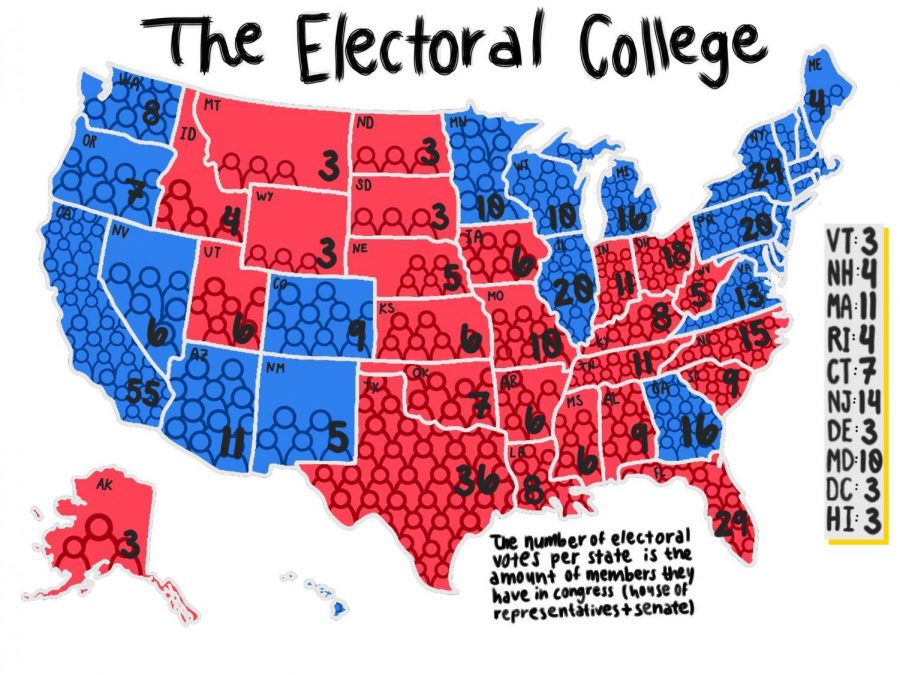Why Did That Take So Long? The Electoral College Explained.
The 2020 presidential election is decided with Democratic candidate, Joseph R. Biden, Jr. elected as the 46th president of the United States. But why did it take so long to decide the winner when one candidate had 4.5 million more votes than the other?
This year is unique for voters because the number of mail-in ballots is double what it has been in previous years, according to Pew Research Center. Due to the Coronavirus pandemic, mail-in ballots were a safer alternative to going to the polls in person. And since there are so many mail-in ballots, it takes more time to count them, which delays the results of which candidate won each state. Additionally, in states like Pennsylvania, mail-in ballots could not start being counted until Nov. 3 due to laws restricting any election preparation.
To understand why Joe Biden won the election instead of Donald Trump , we have to understand the two types of votes: Electoral and Popular.
Popular votes are when adults go to their local polling station and fill out their ballots, deliver their early votes to drop-box locations, or mail in their ballots. The popular vote does not decide the winner of the election, but it does choose, and influence, the state’s electors to vote the same way the state did.
The reason why the electoral college determines the winner over the popular vote is that it gives more representation to lesser populated states. For example, if California has 40 million people and all of them vote Democrat, then out of the 328 million people that live in the United States, California would represent 8% of the total population. This leaves a state like Alaska, a state that has one million people, with close to no representation in the popular vote.
Electors are people from each state that are nominated to represent the state in the Electoral college when voting for the president. For example, the majority of California’s voters, 65.1%, voted Democratic. Therefore, California’s electors voted for the Democratic candidate, Biden.
Each state has a different number of electors based on the sum of their members in the House of Representatives and the number of senators (each state has two). The amount of people each state has in the House of Representatives is based on population, which is why some states have more electors than others.
Since the state of California has 52 members in the House of Representatives, and two senators, the state has 55 electors, the most out of all the states. A smaller populated state like Wyoming has only three electors, because while it still has two senators, Wyoming only has one member in the House of Representatives.
There are a total of 538 electoral votes between all 50 states, but a presidential candidate only needs 270 — the majority of 538 — to win. States like California and others on the West Coast are usually “blue” (Democratic), which is why Trump did not spend much time campaigning in these states. Instead, he focused on “swing” states, states that could go either way, like Michigan, Ohio, Pennsylvania, and Wisconsin.
“Swing states” are the deciding factors in an election. This year swing states such as Michigan and Wisconsin have “flipped” blue, while Iowa and Ohio remained red from 2016. With each state holding an important number of electoral votes, the candidates need to win these to secure the presidency.
Usually, the popular and electoral votes reflect the winning candidate, but this is not always the case. There have been five times in history where a candidate has won the electoral but lost the popular vote, one of which happened in the 2016 Hillary Clinton versus Trump election. Clinton won the popular vote by 2.87 million votes, but Trump won the Electoral College with 306 votes, making him the President.
While the popular vote does not decide the president, states that have less than a 1% lead of votes between each candidate are eligible for a recount. This is the case for Wisconsin and Georgia. A recount could take weeks leaving the U.S. without an actual answer. In 2016, it was not clear who officially won the election, between Hillary and Trump, until Dec. 12, after Nevada and Wisconsin were recounted.
On Nov. 7, Biden won the presidency with both the popular and electoral vote, but with lawsuits filed by the Trump campaign, and with expected recounts in close races, this election is far from over.
Your donation supports the student journalists at Brea Olinda High School! The contribution will help us purchase equipment, upgrade technology, and cover our annual website hosting costs.

Natalie Di Cesaris, a junior, is excited to start her second year as opinion editor for the Wildcat newspaper staff. She competes on varsity swim and water...

Allie Haluska is a junior and is excited to start her second year on the Wildcat staff. She is on the varsity water polo team and swim and competes in...








divid • Jul 31, 2024 at 10:02 pm
“Since the state of California has 33 members in the House of Representatives, and two senators, the state has 55 electors, ” – is it wrong?
Alex Koers • Aug 1, 2024 at 11:29 am
The correct number should be 52 members. Thank you for the correction.